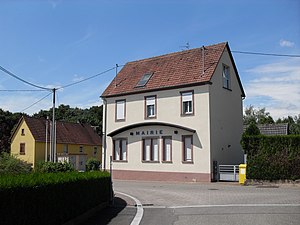Schirrhoffen
| Schirrhoffen | ||
|---|---|---|

|
|
|
| region | Grand Est | |
| Department | Bas-Rhin | |
| Arrondissement | Haguenau-Wissembourg | |
| Canton | Bischwiller | |
| Community association | Haguenau | |
| Coordinates | 48 ° 48 ' N , 7 ° 55' E | |
| height | 119-138 m | |
| surface | 0.63 km 2 | |
| Residents | 694 (January 1, 2017) | |
| Population density | 1,102 inhabitants / km 2 | |
| Post Code | 67240 | |
| INSEE code | 67450 | |
 Mairie Schirrhoffen |
||
Schirrhoffen ( German Schürhofen ) is a French commune with 694 inhabitants (as of January 1, 2017) in the Bas-Rhin department in the Grand Est region (until 2015 Alsace ). The core of the village is connected to the neighboring municipality of Schirrhein .
history
Early ownership
In 1347 the village appears under the name "Schürhof". As a feudal property of the Dotzler family, the settlement was subordinated to the imperial palace of Hagenau . This included a castle, a farm, a chapel, gardens and meadows. The current place name is dated to the time of the French Revolution . It was derived from “Schür”, “Schir” or “Hof” and thus has double roots. In the same year, the Staufer family built a hunting lodge in Schürrieth . The Schürhof and Schürrieth settlements were separated from each other. In 1391 Schürhof passed to Claus Rosenbaum. He came from the patrician Rosenbaum family from Haguenau and was childless. After his death, his sister Catherine took over the settlement, which at the time comprised around 500 lands. The von Eschenau family was formed in their descendants. In 1561, after the Eschenau became extinct, the two secretaries of the Federal Chancellery, Wolfgang Haller and Georges Knod, each took over half of the town. Through their relationships and interventions, they largely managed to save Schürhof from the destruction caused by the Thirty Years War . The successors to Haller and Knod were the Niedheimer family. Were responsible for the locality
- Jean-Jacques Niedheimer from 1593 to 1609,
- Jean-Philippe Niedheimer from 1609 to 1659,
- Jean-Nicolas Niedheimer from 1659 to 1687,
- Jean-Christophe Niedheimer from 1687 to 1693,
- Jean-Frédéric Niedheimer from 1693 to 1750.
The Niedheimers were replaced by Francois-Antoine-Ferdinand Warstatt. At the beginning of the revolution he was the commander of the Schirrhoffen National Guard. In 1793, when the Austrians attacked, he fled to Bühl in southern Baden. His property was confiscated and auctioned.
Jewish community
Schirrhoffen was home to one of the largest Jewish communities in the Bas-Rhin department . A census in 1841 found that 71% of the village population was Jewish. A wave of local Jews emigrated in 1871. When the National Socialists came to power during the Second World War , the Jewish community disappeared completely.
The synagogue was built in 1817 after the Jewish community received a building permit and opened in 1818 on the Saturday before the Jewish New Year celebrations . During the Second World War it was shelled and caught on fire in connection with the liberation from German troops in 1945. Thus the only contemporary witnesses are a Jewish cemetery , dated October 21, 1881, and a private school that a Jew had built in 1844.
Jewish mayors were:
- Thomas Levy from 1844 to 1864,
- Léon Weill from 1865 to 1871,
- Abraham Weill from 1872 to 1881,
- Simon Heymann from 1882 to 1905,
- Salomon Kahn from 1905 to 1907.
Schirrhoffen today
The castle from the early phase still stands on a hill today, and the village grew around this building.
literature
- Le Patrimoine des Communes du Bas-Rhin . Flohic Editions, Volume 1, Charenton-le-Pont 1999, ISBN 2-84234-055-8 , pp. 169-170.

